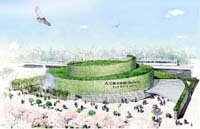 |


 |
|
||
  |
||
|
|
Mitsubishi Group Offsets Carbon Footprint Through Investment in Madagascar’s Rain Forest Makira Forest Project Works to Combat Global Climate Change, Protect Biodiversity and Support Local Communities Aichi, Japan - In an effort to offset the carbon footprint of its environmental education exhibit, ‘Mitsubishi Pavilion@Earth,’ debuting at the 2005 Aichi World Exposition, Mitsubishi Group has provided financial support to help protect rain forests in northeastern Madagascar, the island country located off the coast of Southern Africa. This initiative will offset Mitsubishi’s carbon impacts by preventing the release of carbon dioxide (CO2) into the atmosphere through the protection of a portion of Makira’s threatened forests - which naturally store carbon - and by supporting sustainable activities of local communities in the region. “The Expo is very meaningful, however, it is inevitable that big events like these produce additional greenhouse gas emissions. Thus, offsetting the additional greenhouse gas emissions in another part of the planet is environmentally responsible. I truly hope that carbon offsets like these become customary. The project in Madagascar contributes not only to the protection of the rain forest, but also to the sustainable development of the local community. I feel projects like these are worthy of support by our pavilion ” said Mr. Naoyoshi Yamakawa, Director General of Mitsubishi Pavilion@Earth. Land-use based carbon offset projects such as these are designed to implement actions that simultaneously address global climate change and biodiversity protection while benefiting local community sustainable livelihoods. Healthy, intact forests store carbon taken from the atmosphere and thus play a unique role in mitigating the harmful effects of climate change. Global deforestation accounts for approximately 20 percent of the annual emissions of greenhouse gases, so reducing this source of emissions while protecting biodiversity provides a unique opportunity for governments and policy makers. Wide-scale deforestation is fueling climate change and biodiversity loss, and climate change is expected to accelerate biodiversity loss and species extinctions over the next 100 years. "We must think creatively when it comes to balancing the needs of our people and preventing the plants and animals of our country from going extinct. Organizations like the Wildlife Conservation Society and Conservation International make it possible to demonstrate to the world just how valuable Makira's forests are." said Madame Andriantsilavo, Secretaire General of Madagascar’s Ministry of the Environment, Waters and Forests. The Makira forest region, which consists of about 350,000 hectares (approximately 1,350 square miles), is one of the largest remaining patches of rain forest on the island. Within the forest, the level of species diversity is among the highest in the country including a number of critically endangered animals such as the Madagascar serpent eagle (Eutriorchis astur) and at least two species of Malagasy lemurs including the red ruffed lemur (Varecia variegata rubra) and the silky sifaka (Propithecus diadema candidus) which are found only in Madagascar. The primary threats to Makira are from slash and burn agriculture, uncontrolled bush fires, and mining. The island of Madagascar itself is classified by scientists as one of the most important biodiversity hotspots in the world. A preponderance of species diversity is found exclusively within the earth’s 34 biodiversity hotspots, which combined, cover a very small percentage of the Earth’s land surface. Madagascar contains 22 Families (a higher level taxonomic distinction after “species” and “Genus”) of plants and animals that are found nowhere else on earth. Each biodiversity hotspot has already lost over 70 percent of original habitat, and the remainder faces imminent threat of further destruction. Madagascar, for example, has lost as much as 90 percent of its original forest cover. “Through the Makira Forest Project, we working with the Malagasy Ministry of Environment, Water and Forests to have Makira officially declared a ‘conservation site’,” said Helen Crowley, Madagascar Country Director for the Wildlife Conservation Society. “This classification will help us successfully reduce deforestation within the Makira Forest Project area by implementing legal forest protection measures that allow for sustainable natural resource management by local communities.” Specific activities that directly reduce deforestation include training on permaculture practices that allow farmers to continually produce good harvests from the same land as opposed to cutting new fields every few years. The project has also been empowering local communities the transfer of natural resource management rights from the government. This in turn allows the communities themselves to mange their forests and makes them responsible for enforcing forest-use rules. Additional projects include building improved irrigation infrastructure for the lowland rice growing areas. An active dialogue will be maintained with local stakeholders to help ensure protected area limits are proposed and accepted by local and regional authorities. An initial study and subsequent carbon analysis of Makira conducted by Winrock International quantified the amount of carbon stored in the Makira Forest Site. On behalf of the Government of Madagascar, Conservation International has begun marketing these “Conservation Carbon” emissions reductions or carbon credits associated with the carbon sequestered in the region’s forests. Currently, investments in these types of carbon credits remain voluntary because avoided carbon emissions resulting from reduction in deforestation rates are not yet included in the rules defined by the Kyoto Climate Treaty. “While not yet recognized under Kyoto, many organizations see value in investing in ‘Conservation Carbon’ because of the multiple benefits achieved through reducing climate change, protecting biodiversity and supporting local communities,” said Michael Totten, Senior Director of Climate Change at Conservation International. By working in an innovative partnership with the Government of Madagascar and the Wildlife Conservation Society , Conservation International has also secured previous funding for the Makira Forest Project through its “Conservation Carbon” Program from the musical group Pearl Jam, the Vans Warped Tour and NAVTEQ. To further public awareness about Madagascar, and the Makira region, WCS will open an exhibit at its Bronx Zoo headquarters next year.
Conservation International’s Center for Environmental Leadership in Business (CELB) provides a new forum for collaboration between the private sector and the environmental community. Created in partnership with Conservation International (CI) and the Ford Motor Company, CELB operates as a division of CI and is governed by a distinct executive board of leaders from the business and environmental communities-engaging the private sector worldwide in creating solutions to critical global environmental problems in which industry plays a defining role. For further information about CELB, please visit celb.org. 
|
MEDIA CONTACT Katrin Olson CELB [email protected] 703-341-2768 ONLINE NEWSROOM MATERIALS Fact Sheets: • Makira Forest Project Factsheet (987kb PDF) Related Links: • CELB's Climate Change Program • Wildlife Conservation Society • Madagascar In-Depth • Mitsubishi Pavilion @Earth Website • Expo 2005 Aichi Official site • Natsource Website For High Quality Photographs of the Makira Forest Project contact
 © CI, Russell A. Mittermeier Black and White Ruffed Lemur  courtesy Mitsubishi Group Mitsubishi Pavilion@Earth |
|